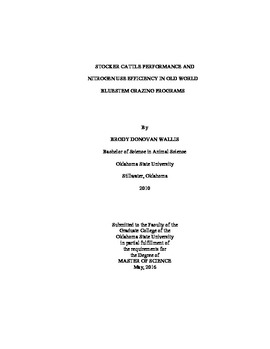| dc.contributor.advisor | Horn, Gerald W. | |
| dc.contributor.author | Wallis, Brody Donovan | |
| dc.date.accessioned | 2017-02-22T22:16:52Z | |
| dc.date.available | 2017-02-22T22:16:52Z | |
| dc.date.issued | 2016-05-01 | |
| dc.identifier.uri | https://hdl.handle.net/11244/49178 | |
| dc.description.abstract | In grazing systems only 5-30% of ingested nitrogen (N) is retained in BW gain of growing beef cattle. A two-year study was conducted to evaluate N fertilizer and DDGS as sources of N and N use efficiency for growing beef cattle grazing Plains Old World bluestem. In year 1 (2010) heifers (n= 235; 274 � 33 kg BW) grazed 12 pastures (3 pastures/treatment) from May 18 � Sept. 28 and in year 2 (2011) steers (n= 233; 238 �23 kg BW) grazed 12 pastures from May 17 � July 19 in a completely randomized design comparing 4 treatments: (1) non-fertilized, low-stocked (336 kg of BW/ha) pastures (CONT); (2) N fertilized (90 kg N/ha), high-stocked (672 kg of BW/ha) pastures (NFERT); (3) N and phosphorus (P) fertilized (90 kg N/ha; 39 kg P/ha), high-stocked pastures (NPFERT); and (4) non-fertilized, high-stocked pastures plus supplementation of dried distillers grains with solubles (DDGS; 0.75% BW�hd-1�d-1). Year 1 weight gain per hectare (kg/ha) was highest (P < 0.01) for treatment 4 and lowest for treatment 1 with 2 and 3 being intermediate. Year 2 weight gain per hectare (kg/ha) was highest (P < 0.01) for treatments 3 and 4 and lowest for treatment 1 with 2 being intermediate. Treatment 1 had the lowest gain/ha due to the difference in stocking rate. In both years total N inputs (kg/ha) for treatment 4 were greater (P < 0.01) than treatment 1, and both were less than treatments 2 and 3. In both years N retention in BW gain/ha for treatment 4 was higher (P < 0.01) compared with treatments 1, 2, and 3, respectively. N recovery (%) was greatest (P < 0.01) for treatment 1 because of the low N inputs. However, replacing N fertilizer with DDGS supplementation improved (P < 0.01) N recovery by 3.0-fold in year 1 and by about 5-fold in year 2 compared with treatments 2 and 3, respectively. These data indicate that DDGS can be effectively used in stocker cattle grazing programs to increase stocking rates, increase BW gain/ha, and increase N recovery of the grazing program. | |
| dc.format | application/pdf | |
| dc.language | en_US | |
| dc.rights | Copyright is held by the author who has granted the Oklahoma State University Library the non-exclusive right to share this material in its institutional repository. Contact Digital Library Services at lib-dls@okstate.edu or 405-744-9161 for the permission policy on the use, reproduction or distribution of this material. | |
| dc.title | Stocker Cattle Performance and Nitrogen Use Efficiency in Old World Bluestem Grazing Programs | |
| dc.contributor.committeeMember | Lalman, David L | |
| dc.contributor.committeeMember | Warren, Jason G | |
| osu.filename | Wallis_okstate_0664M_14599.pdf | |
| osu.accesstype | Open Access | |
| dc.description.department | Animal Science | |
| dc.type.genre | Thesis | |
| dc.type.material | text | |
